Rembo Bongo, Part 2
 View of the channel leading into Lac Mafoume, September 2007
View of the channel leading into Lac Mafoume, September 2007 Photo taken in almost the same place last week. The tip of the log sticking out of the water is the top of the large fallen tree in the background of the photo above.
Photo taken in almost the same place last week. The tip of the log sticking out of the water is the top of the large fallen tree in the background of the photo above.
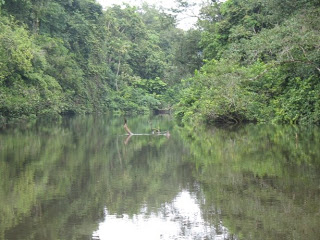 Where there were fields divided by channels of water last year, there was now an enormous lake 3 times the size. Grassy areas along the borders were shallower, only a few feet deep. As we started around the lake we began to find a few manatees feeding and swimming among the grasses.
Where there were fields divided by channels of water last year, there was now an enormous lake 3 times the size. Grassy areas along the borders were shallower, only a few feet deep. As we started around the lake we began to find a few manatees feeding and swimming among the grasses.

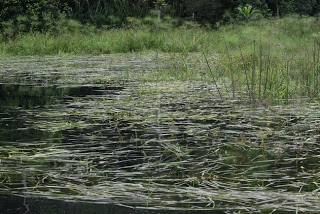 A manatee swims off through the Polygonum plants but never graces us with a view! We had 3 sightings in this lake which was a bit lower than I expected, but because I wanted to see the entire lake, we didn’t have time to really sit and wait for long periods in any one spot. At least I know they’re there for next time.
A manatee swims off through the Polygonum plants but never graces us with a view! We had 3 sightings in this lake which was a bit lower than I expected, but because I wanted to see the entire lake, we didn’t have time to really sit and wait for long periods in any one spot. At least I know they’re there for next time.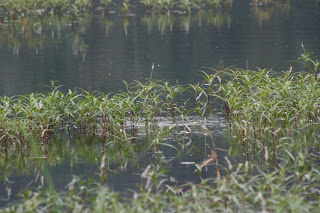 We saw some other nice wildlife on Lac Mafoume as well:
We saw some other nice wildlife on Lac Mafoume as well:
Hartlaub’s Duck. We also saw large flocks of these guys flying up the Rembo Bongo.
 We saw several groups of Putty-nosed monkeys along the lake edge. This one was quite curious.
We saw several groups of Putty-nosed monkeys along the lake edge. This one was quite curious. Tiny bird’s nest built out over the water. It probably belongs to one of the little flycatchers we see flitting everywhere along the lakes and rivers here.
Tiny bird’s nest built out over the water. It probably belongs to one of the little flycatchers we see flitting everywhere along the lakes and rivers here. A young water monitor Lizard (Varans ornatus) relaxing on a log.
A young water monitor Lizard (Varans ornatus) relaxing on a log. The following day was bright and sunny and we went to Lac Gore, the closest large lake to Ingoueka, the village where we stayed. This lake was basically a sea of grass that stretched for miles.
The following day was bright and sunny and we went to Lac Gore, the closest large lake to Ingoueka, the village where we stayed. This lake was basically a sea of grass that stretched for miles.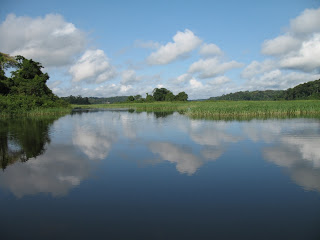 Another view of Lac Gore. There were also huge coves filled with water lilies, another favorite food of manatees. But despite enough food for herds of manatees and sighting recent feeding sign, we only had 2 sightings in this lake. I’m not sure why, although as with Lake Mafoume, I wanted to get an idea of the entire place, so we didn’t sit in any one spot for very long.
Another view of Lac Gore. There were also huge coves filled with water lilies, another favorite food of manatees. But despite enough food for herds of manatees and sighting recent feeding sign, we only had 2 sightings in this lake. I’m not sure why, although as with Lake Mafoume, I wanted to get an idea of the entire place, so we didn’t sit in any one spot for very long. 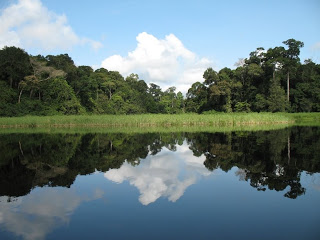 On our last morning we surveyed two small lakes, Mouaga and Marimossi (view below), before traveling back down the Rembo Bongo to Gamba (a 3 hour trip). We didn’t see any manatees or recent feeding sign, and the close proximity of these likes to the village might deter manatees from using them as much.
On our last morning we surveyed two small lakes, Mouaga and Marimossi (view below), before traveling back down the Rembo Bongo to Gamba (a 3 hour trip). We didn’t see any manatees or recent feeding sign, and the close proximity of these likes to the village might deter manatees from using them as much.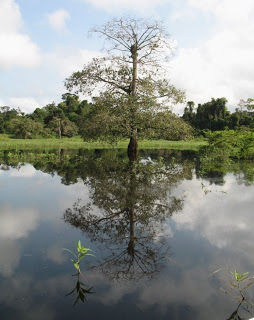
So all in all we had 10 sightings comprising 13 individual manatees in the lakes over 3 days. For this part of the world, that’s a pretty high sighting frequency and it’s obvious there is plenty of great habitat. I feel privileged to be able to see this amazing remote place where so few people ever get to go.



No Comments